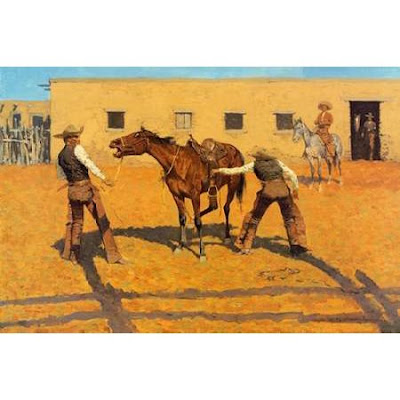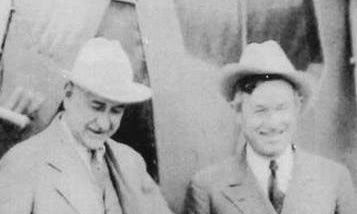 |
| His First Lesson - Frederic Remington 1903 |
This weeks very interesting docent class was all about Amon G. Carter, Frederic Remington, and Charles M. Russell. Dr. Ron Tyler, former director of the ACMAA, conducted the first part of the class which I prefer to call "How a Relationship Between an Oil Man and a Humorist Resulted in a Museum." Active docents kindly gave their time to give us talks on some art works by Remington and Russell.
One thing is for sure - the more you know the more you know you don't know. That is how I felt after the class which was one part art appreciation and two parts history. Both parts worked well to introduce us to two very well known western artists and one very well known Ft Worth businessman. I say introduce because it is impossible to cover three lives such as these in a short three hour period.
So how does the relationship between a true self-made millionaire, Amon G. Carter and one of America's best love humorists, Will Rogers, result in an art museum.
 |
| Amon G. Carter and Will Rogers |
During the course of their friendship Mr. Rogers suggested Mr. Carter invest in Western art. His first documented purchases were the above Remington, "His First Lesson" and nine Russell water colors. He continued to purchase Remington and Russell works for many, many years. Mr. Carter loved Ft Worth and always promoted this area at every opportunity. Because he had been poor as a youth he stated his extensive collection of Western art should be displayed in a museum for all to see and enjoy. Thus the Amon Carter Museum of Western Art was created. Sadly he did not live to see the museum. The name has been changed to The Amon Carter Museum of American Art as it has grown to reflect American art from the beginning to the 1950s. More on that as we journey along.
The last half of the class was devoted to eight works by the two artists including "His First Lesson" above. each one portrays a period, albeit sometimes romanticized, in the American west. Each was described by the active docents as to what it meant and how it was achieved. Obviously the artists did a great deal of work in their studios however they had lived and worked in the west so were accurate in their translations. The history behind these works is fascinating but far too much for me to relate in a small blog. I have at least one question under each picture to give you something to research. Online searches will yield for you a wealth of information - or if close enough visit the Amon Carter Museum and check in it's library.
 |
| A Dash For The Timber - Frederic Remington 1889 |
 |
| The Bronco Buster Bronze - Frederic Remington 1914 |
 |
The Buffalo Hunt [No. 39] - Charles M. Russell 1919 |
 |
| Indian Women Moving - Charles M. Russell 1898 |
 |
| The Medicine Man - Charles M. Russell 1908 |
 |
| The Fall of the Cowboy - Frederic Remington 1895 |
 |
| Through the Smoke Sprang the Daring Soldier - Frederic Remington 1897 |
Have some fun looking up the answers.
Adios until next week,
Caroline
No comments:
Post a Comment